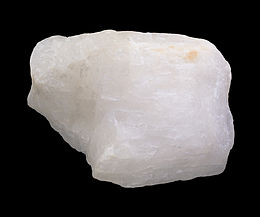ക്രയോളൈറ്റ്
സോഡിയം, അലൂമിനിയം, ഫ്ലൂറിൻ എന്നിവയുടെ ഒരു സംയുക്തമായ ധാതുവാണ് ക്രയോളൈറ്റ് (Cryolite). സോഡിയം ഹെക്സാഫ്ലൂറോ അലൂമിനേറ്റ് എന്ന രാസനാമമുള്ള ഇതിന്റെ രാസസൂത്രം Na3AlF6 എന്നാണ്. ചരിത്രപരമായി അലൂമിനിയത്തിന്റെ ഒരു അയിര് ആണ് ക്രയോളൈറ്റ്. പിൽക്കാലത്ത് അലൂമിനിയത്തിന്റെ ഓക്സൈഡ് അയിരായ ബോക്സൈറ്റ് നിർമ്മാണത്തിലും ഉപയോഗിച്ചു തുടങ്ങി. ഓക്സൈഡ് അയിരിൽ നിന്നും ഓക്സിജൻ വേർതിരിക്കുന്നത് അത്ര എളുപ്പമല്ല. ക്രയോളൈറ്റ് ഒരു ഫ്ലക്സ് ആയി ഉപയോഗിച്ചാണ് ഇത് പരിഹരിക്കുന്നത്.
| ക്രയോളൈറ്റ് (Cryolite) | |
|---|---|
 Cryolite from Ivigtut Greenland | |
| General | |
| Category | Halide mineral |
| Formula (repeating unit) | Na3•AlF6 |
| Strunz classification | 3.CB.15 |
| Dana classification | 11.6.1.1 |
| Crystal symmetry | P21/n |
| യൂണിറ്റ് സെൽ | a = 7.7564(3) Å, b = 5.5959(2) Å, c = 5.4024(2) Å; β = 90.18°; Z = 2 |
| Identification | |
| Formula mass | 209.9 g mol−1 |
| നിറം | Colorless to white, also brownish, reddish and rarely black |
| Crystal habit | Usually massive, coarsely granular. The rare crystals are equant and pseudocubic |
| Crystal system | Monoclinic |
| Twinning | Very common, often repeated or polysynthetic with simultaneous occurrence of several twin laws |
| Cleavage | None observed |
| Fracture | Uneven |
| Tenacity | Brittle |
| മോസ് സ്കെയിൽ കാഠിന്യം | 2.5 to 3 |
| Luster | Vitreous to greasy, pearly on {001} |
| Streak | White |
| Diaphaneity | Transparent to translucent |
| Specific gravity | 2.95 to 3.0. |
| Optical properties | Biaxial (+) |
| അപവർത്തനാങ്കം | nα = 1.3385–1.339, nβ = 1.3389–1.339, nγ = 1.3396–1.34 |
| Birefringence | δ = 0.001 |
| 2V angle | 43° |
| Dispersion | r < v |
| Melting point | 1012 °C |
| Solubility | Soluble in AlCl3 solution, soluble in H2SO4 with the evolution of HF, which is poisonous. Insoluble in water.[1] |
| Other characteristics | Weakly thermoluminescent. Small clear fragments become nearly invisible when placed in water, since its refractive index is close to that of water. May fluoresce intense yellow under SWUV, with yellow phosphorescence, and pale yellow phosphorescence under LWUV. Not radioactive. |
| അവലംബം | [2][3][4][5][6] |
ശുദ്ധമായ ക്രയോളൈറ്റ് 1012 °C (1285 K) ൽ ഉരുകുന്നു. ഇത് അലൂമിനിയം ഓക്സൈഡിനെ എളുപ്പത്തിൽ ലയിപ്പിക്കുന്നു. ഇങ്ങനെ ലഭിക്കുന്ന ലായനിയിൽ നിന്നും ഇലക്ട്രോളിസിസ് മാർഗ്ഗത്തിലൂടെ അലൂമിനിയം വേർതിരിക്കുന്നു. ഇതിനുവേണ്ടിയുള്ള ക്രയോളൈറ്റ് പ്രകൃതിയിൽ നിന്നും ആവശ്യത്തിന് മാത്രം ലഭിക്കാത്തതിനാൽ, കൃത്രിമമായി, ഫ്ലൂറൈറ്റ് ഉപയോഗിച്ച് സോഡിയം അലൂമിനിയം ഫ്ലൂറൈഡ് നിർമ്മിക്കുന്നു.
1798ൽ ഡാനിഷ് വെറ്റിനറി സർജനായ Christian Abildgaard Peder (1740–1801) ആണ് ക്രയോളൈറ്റിനെക്കുറിച്ച് ആദ്യമായി വിവരിച്ചത്[7] വ്യാവസാക ആവശ്യങ്ങൾക്ക് ലഭിക്കാത്ത തരത്തിൽ, ക്രയോളൈറ്റ് ലഭ്യത തീർത്തും കുറഞ്ഞിരിക്കുന്.[8].
ഉപയോഗം
തിരുത്തുകകീടനാശിനി, ക്ഷുദ്രജീവനാശിനി എന്നിവയായും [9], വെടിക്കെട്ടിന് മഞ്ഞപ്രഭ നൽകുന്നതിനും[10] ക്രയോളൈറ്റ് ഉപയോഗിക്കുന്നു. ഉരുകിയ ക്രയോളൈറ്റ് അലൂമിനിയം ഓക്സൈഡ് (Al2O3) ലയിപ്പിക്കുന്നതിനുള്ള ലായകമായി ഹാൾ - ഹെറോൾട്ട് പ്രക്രിയയിൽ ഉപയോഗിക്കുന്നു. അലൂമിനിയം ഓക്സൈഡിന്റെ ദ്രവണാങ്കം 2000–2500 °C ൽ നിന്നും 900–1000 °C ആയി കുറയ്ക്കുക്കുന്നതിനും അങ്ങനെ അലൂമിനിയം നിർമ്മാണം എളുപ്പമാക്കുന്നതിനും സഹായിക്കുന്നു.
അവലംബം
തിരുത്തുക- ↑ CRC Handbook of Chemistry and Physics, 83rd Ed., p. 4-84.
- ↑ Gaines, Richard V., et al (1997) Dana's New Mineralogy, Wiley, 8th, ISBN 978-0-471-19310-4
- ↑ Cryolite: Cryolite mineral information and data. Mindat.org (2010-10-03). Retrieved on 2010-10-25.
- ↑ Cryolite Mineral Data. Webmineral.com. Retrieved on 2010-10-25.
- ↑ Cryolite, Handbook of Mineralogy. Retrieved on 2010-10-25.
- ↑ Hurlbut, Cornelius S.; Klein, Cornelis, 1985, Manual of Mineralogy, 20th ed., John Wiley and Sons, New York ISBN 0-471-80580-7
- ↑ See:* (Abildgaard) (1799) "Norwegische Titanerze und andre neue Fossilien" (Norwegian titanium ores and other new fossils [i.e., anything dug out of the earth]), Allgemeines Journal der Chemie, 2 : 502. From p. 502: "In der ordenlichen Versammlung der königl. Gesellschaft der Wissenschaften am 1. Februar dieses Jahres stattete Hr. Prof. Abildgaard einen Verricht über die Norwegischen Titanerze und über die von ihm mit denselben angestellten Analysen ab. Zugleich theilte er auch eine Nachricht von einer vor wenigen Jahren aus Grönland nach Dänemark gebrachten besonders weißen spathartigen Miner mit. Einer damit angestellten Untersuchung zu folge bestand sie aus Thonerde und Flußspathsäure. Eine Verbindung, von welcher noch kein ähnliches Beyspiel im Mineralreich vorgekommen ist. Sie hat den Namen Chryolit erhalten, weil sie vor dem Löthrohre wie gefrorne Salzlauge schmilzt." (At the ordinary session of the [Danish] Royal Society of Science on February 1st of this year, Prof. Abildgaard presented a report about Norwegian titanium ores and about the analysis of them undertaken by him. He also communicated a notice of an especially white, spar-like mineral that was brought several years ago from Greenland to Denmark. According to an investigation performed on it, it consists of alumina and hydrofluoric acid. A compound of which no similar example in the mineral realm has yet been found. It received the name "cryolite" because under a blowpipe, it melts like frozen brine.)
- P. C. Abildgaard (1800) "Om Norske Titanertser og om en nye Steenart fra Grönland, som bestaaer af Flusspatsyre og Alunjord" (On Norwegian titanium ores and on a new mineral from Greenland, which consists of hydrofluoric acid and alumina), Det Kongelige Danske Videnskabers-Selskabs (The Royal Danish Scientific Society), 3rd series, 1 : 305-316. Abildgaard named cryolite on p. 312: "Han har kaldt denne grönlandske Steen Kryolith eller Iissteen formedelst dens Udseende, og fordi den smelter saa meget let for Blæsröret." (He has named this Greenlandic stone cryolite or ice stone on account of its appearance, and because it melts so easily under a blowpipe.)
- ↑ "Royal Society of Chemistry, Chemistry in its element: compounds - Cryolite". Archived from the original on 2016-04-18. Retrieved 2016-04-08.
- ↑ EPA R.E.D. FACTS Cryolite http://www.epa.gov/oppsrrd1/REDs/factsheets/0087fact.pdf
- ↑ Helmenstine, Anne Marie. "How Firework Colors Work and the Chemicals That Make Vivid Colors". ThoughtCo (in ഇംഗ്ലീഷ്). Retrieved 2019-09-01.